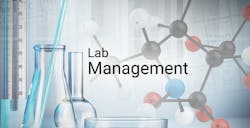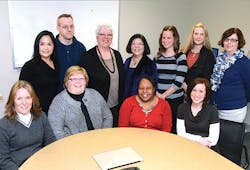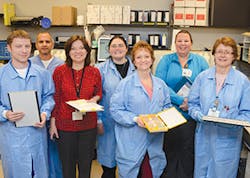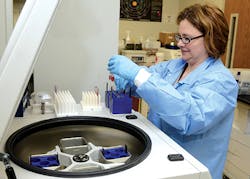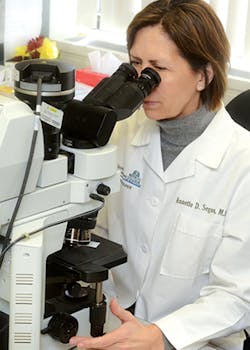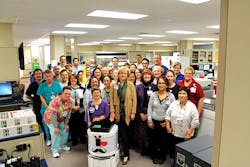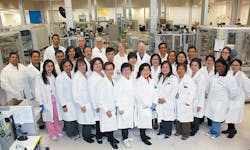Milwaukee, Wisconsin, is something of an unknown gem among major American cities. It is a city of neighborhoods, with rich ethnic traditions, local color and cuisine, a variety of world-class cultural opportunities, and a fascinating architectural mix. It has a vibrant and busy downtown, a beautiful lakefront, superb museums, distinguished educational institutions, and it has the Bucks and the Brewers, sports fans. Milwaukee and surrounding suburbs often appear on lists of “good places to live.”
Top photo: CHW Lab of the Year nomination team
Bottom left photo: Staff of the CHW histology group
Bottom right photo: Elisabeth Glaser, molecular technologist,
processes samples for flow cytometry.
Milwaukee also has something else going for it: the Children’s Hospital of Wisconsin (CHW). The editors of Medical Laboratory Observer have chosen the CHW Laboratory as the 2015 Lab of the Year. We salute the CHW Lab and the two runners-up, University Medical Center of Southern Nevada Department of Laboratory Services in Las Vegas, Nevada; and The Permanente Medical Group (TMPG) Regional Reference Laboratory in Berkeley, California.
The choice was not an easy one. Many excellent labs submitted nomination forms, and all are to be congratulated on their commitment to laboratory medicine and to the patients they serve. All labs should give themselves a pat on the back, this month, as we celebrate Medical Laboratory Professionals Week, April 19-April 25, 2015.
Children’s Hospital of Wisconsin is a 306-bed hospital with two offsite outpatient locations. CHW is a busy place; in 2013, the last year for which there are complete figures, it had nearly 24,000 inpatient admissions, 62,000 emergency department visits, and 300,000 outpatient visits. The Pathology and Laboratory Medicine department has more than 100 employees and produces an estimated 900,000 billed test annually.
Those are the bare bones. But what makes the CHW Lab outstanding? What makes it special? Please read on.
Meeting the needs of children
The staff of the CHW Lab is acutely aware of the fact that the vast majority of their patients are children—and all workers are dedicated to being sensitive to their young patients’ needs. This is especially important at the Lab’s point of contact with most of its customers: the phlebotomy department. Phlebotomists are trained to explain and demystify an experience that is often frightening to children.
Moreover, as Altheia Roquemore-Goins, MS, MT(ASCP), the CHW Lab’s Administrative Director, pointedly says, “the phlebotomy staff is aware that a blood draw is a scary experience for the parent and child.” The use of small 23-gauge butterfly needles is standard procedure, as are other measures to decrease discomfort, including the use of a sugar water solution for younger children, freeze spray, and pet therapy.
In addition, the Lab has taken the lead in adding on tests or combining draws when possible, and utilizing alternative specimen types to avoid additional pokes.
The CHW Lab has also implemented technology that enables faster time-to-result and thus an earlier diagnosis and commencement of treatment. For example, lab leaders have brought Group A strep PCR testing in-house.
With the implementation of PCR testing and staff training to perform additional runs, the average turnaround time (TAT) for a Group A strep PCR is about eight hours, compared to 48 hours for cultures. Similarly, the Microbiology department recently validated a high-tech instrument capable of identifying microorganisms based on protein composition. The matrix-assisted laser desorption ionization-time of flight mass spectrometry (MALDI-TOF MS) technology can identify bacteria and yeast species within 24 hours with a high level of accuracy.
Another example of the CHW Lab’s dedication to improving patient outcomes is its recent implementation of a complete Pediatric Pathology Muscle and Nerve Lab. By adding a pediatric neuropathologist to the medical staff, CHW has entered an extremely sub-specialized field; few other laboratories in the country offer similar testing. Since it does not need to send out muscle and nerve biopsies for analysis, the Lab can offer biopsy analysis with reduced TAT and thus faster diagnosis.
CHW Lab leaders also tout the lab’s role in the hospital’s newborn screening program. The Lab serves as a gatekeeper to make sure the samples are collected and ordered properly, that the correct information is on the testing cards, and that the cards are sent promptly to the state lab. In 2014 the CHW Lab spearheaded a variety of mechanisms to improve its data, including a streamlined data entry process in the electronic health record, additional screening of specimen acceptability, and additional courier runs to assure the cards get to the state promptly.
Going all out to go Lean
In 2011, the Lab began a complete Lean transformation in the core laboratory. The goal, says Molly Thieme, MPA, MLS(ASCP), Diagnostics QI/Education Coordinator, was “to identify waste and modify processes to include only value-added functions whenever possible.” The outcome was a complete physical redesign of the core laboratory, revised and streamlined bench assignments, and a total remodel of the Core Lab, Hematology, and Chemistry departments. This was done in phases, so it would not interrupt laboratory services. “Lean is an ongoing process,” notes Roquemore-Goins. “2014 was a big year for us in terms of achieving some of our Lean metrics.”
The newly created floor plan allowed addition of instrumentation and more efficient sample flow through the laboratory. A core cell was created, which included all of the high-volume chemistry, hematology, and coagulation analyzers. Implementing this design and reducing steps have allowed these instruments to be run by fewer laboratorians than in the past, and combining and redesigning benches has allowed all shifts in Core Lab to be able to work with fewer people.
The experience and expertise gained through the Core Lab Lean transformation was just the beginning. The Molecular department, which houses all molecular diagnostics and molecular infectious testing, went through a major expansion and redesign to allow for more test development and an expanded test menu. This remodel allowed the Lab to accommodate the acquisition of state-of-the art instrumentation, research and development of clinical assays, unidirectional workflow, and increased specimen volumes. In 2014, the Molecular Microbiology laboratory formed another Lean team to evaluate processes and determine the best way to utilize staff. Major outcomes were level-loading work volume and expanding coverage to accommodate the increasing volume of PCR tests.
The Lab’s Lean efforts have had a significant impact on productivity and service and have reduced TAT. In core Chemistry and Hematology, about 95% of all tests resulted in stat TAT, regardless of whether they are ordered stat or where they are drawn. Laboratory Information Sysem (LIS) manager Sheila Lawson, MBA, notes that in the past two years the Lab has added several major pieces of equipment and successfully brought in-house more than 20 moderate to highly complex tests. Says Thieme, “We’ll never be done with Lean; our goal is continuous improvement.”
The “Chematology” Lab and MDx
According to Jason Jarzembowski, MD, PhD, Interim Medical Director of the CHW Lab, the Lab is committed to “maintaining quality while being cost-effective. We have achieved this with several approaches, both subtle and grand.”
He explains one of those approaches: “We have combined the Chemistry and Hematology departments into one, now called Chematology. The Chematology Lab is a blend of highly trained technologists who perform tasks in both Hematology and Chemistry. By merging these departments and incorporating Lean techniques, staff members are sent to the areas where the workflow dictates, thus improving the efficiency of both departments.” Adds Karen Kutschenreuter, Laboratory Manager of Hematology and Chemistry, “All the hematologists and chemists are trained in the basic areas of our Core Lab.”
Because of cross-training, all day-shift FTEs at the CHW Lab can run all the automated instruments in Chemistry, Hematology and Coagulation. Cross-training has also extended into specimen processing, blood gas testing, and manual chemistry tests. This versatility also has expanded testing availability. For example, in the past, a limited number of techs were trained to perform thrombelastograph (TEG) testing, and it was generally available only during day shift. Now, all second and third shift FTEs have been trained, so the test is always available. Some members of Chematology have also cross-trained in flow cytometry, biochemical genetics, and molecular diagnostics. Esoteric testing has also been enabled by the efficiencies inherent in the Chematology Lab.
The CHW Lab has been performing molecular testing for 15 years, and Lab leaders report that it has increased its capabilities substantially during the past year. The test menu was expanded to include more viral load testing, while avoiding first shift overtime and eliminating a stressful environment for the day shift. As Barbara Roettgen, MSM, MT(ASCP), explains, “the plan included adding a ‘mid-shift’ technologist to carry out the viral load testing on molecular equipment on the off shift.” This laboratorian also assists in reporting results and test troubleshooting as needed. When the workload increases—for example, during a respiratory viral outbreak—the mid-shift technologist performs additional testing and any prep work that is needed for the next day shift.
More broadly, the Molecular Diagnostics department has been aggressively innovative. Combining pharmacology with genomics, it has developed various pharmacogenetic testing panels. One, the Epilepsy Gene Panel (EPGENE), assesses the patient’s genotype for drug metabolizing enzymes and a drug transporter protein, responsible for metabolism of drugs prescribed for the treatment of epilepsy. Genotypes discovered through this test may help clinicians manage medication. The department also has partnered with researchers and clinicians from the Otolaryngology department to develop and implement a comprehensive hearing loss DNA test. “We worked with Otolaryngology to develop this testing panel of some of the more common hearing-loss genes,” Dr. Jarzembowski notes. The multiplatform test incorporates full gene sequencing, real-time PCR, and Sanger sequencing to screen for genetic variants associated with non-syndromic hearing loss. The panel includes testing for mutation variations and deletions, and its implementation has helped to identify at-risk infants.
QC: a comprehensive approach
Says Administrative Director Roquemore-Goins: “Our Lab’s quality system plan is applied to all operational systems or activities along the specimen testing workflow.” The Clinical Laboratory’s path of workflow consists of pre-analytic, analytic, and post-analytic processes, or operational systems, beginning with an order for a laboratory test, tissue analysis, or blood product and proceeds to provision of the report or blood product. It also includes any necessary clinical consultation for appropriate test utilization and/or interpretation. “We have a multi-disciplinary blood utilization committee that evaluates how efficiently we are using blood, and we partner with surgery and other sub-specialties to implement technology like TEG in the main laboratory to minimize the use of blood products for open-heart surgeries and transplants.”
Every department within the Lab is involved in the overall Quality Management program. Monthly reports are prepared which include lab dashboard and metrics, occurrence management, facilities and safety rounds, and proficiency testing review. Nineteen different lab departments prepare quarterly reports, detailing updates and changes regarding document control, process control, equipment, purchasing and inventory, as well as specific data to show selected process improvement initiatives and monitors within the department. These reports are presented to the Lab Quality Committee, which consists of Laboratory Leadership and members of each department.
The CHW Lab’s quality initiatives have driven significant improvements. Thieme gives one example: In 2012, the Lab was getting up to 30 percent of syringe specimens with the required source missing or incorrect. The Lab partnered with nursing leadership, and through documentation and education, reduced this error rate to less than one percent and has maintained this improvement for more than two years.
The Lab has multiple systems in place to track deviations from process/procedure or safety events that impact the patient or laboratory results and implement quality improvement. Events involving departments outside the lab are documented in a hospital-wide system and reviewed by department leadership, Lab, and hospital Quality. Follow-up and response are required within seven days of the event—a policy that is consistent with the CHW Lab’s holistic, meticulous, and comprehensive approach to QA/QC.
Professional development & reaching out
Says LeAnne Noll, Flow Cytometry/Molecular Technologist: “The end goal for creating more professional development opportunities is to have a laboratory full of experts.” The CHW Lab’s leaders decided that the best approach to achieving this goal was to create a professional staff development program and career ladder system for technologists. Research was conducted across the nation on institutions that already utilize this type of system, and from this data they created career ladders that contain three different laboratory assistant, technician, and technologist levels that are tied to three different pay scales. The technologist levels are differentiated based on knowledge required by the position, supervisory controls, guidelines, complexity, scope and effect, personal contacts, and purpose of contacts. The leaders hope that once this is implemented, it will set forth a clear path for learning and growing and encourage motivated laboratorians to seek opportunities for advancement. Presently, final drafts for the technologist career ladder in Chematology and Microbiology are ready to be submitted to the hospital’s human resources department for approval.
Even as the Lab seeks to refine ways for its employees to grow professionally, its leaders and staff are active in giving back to the Milwaukee-area community and beyond. The Lab regularly sponsors dinners for guests staying at the local Ronald McDonald House, which is one of the largest in the United States. It is also closely involved in Al’s Run, an annual hospital fundraiser, and fundraising related to the local United Way. The lab also supports Project Search, a program to enable people with disabilities to learn job skills, and accepts job interns related to this program.
The “giving back” activity that is most intriguing, perhaps, is the involvement that the Lab’s leadership and faculty have had with building a clinical laboratory in Peru. Paula North, MD, PhD, the Lab’s medical director until late last year, has for several years collaborated with Dr. Luis Vasquez of the Yantalo Peru Foundation to build a private clinic and diagnostic center in the rainforest of northern Peru, including an innovative, region-appropriate clinical laboratory with select molecular, as well as more “routine” diagnostic services. Funded in part by a Humanitarian Award from the College of American Pathologists (CAP) and an exporatory planning grant from the Fogarty International Center, Dr. North assembled a team of CHW clinical scientists to design, implement, and oversee this remote lab. Dr. North and Dr. Sue Kehl continue to lead teams of staff and students to Peru several times a year to help set up and provide guidance for the new diagnostic lab, which also serves as a center for environmental health research and training. The CHW Lab has also provided training to Peruvian lab staff visiting at CHW.
__________
One morning a few months ago, a pipeline broke above the CHW Lab’s Blood Bank department. Immediately, the team got together and moved the entire Blood Bank to another room in an adjacent but separate building while others cleaned and decontaminated the space. All this was done with no delays to patient care. The process of moving the entire department, getting replacement equipment, getting the Blood Bank staff online again, and then moving them back to their space, took about a day and a half. It required a lot of coordination and cooperation, and many people worked together as a team to respond to that challenge.
That anecdote, provided by LIS manager Lawson, seems to the editors of MLO to exemplify the excellence, work ethic, and institutional spirit of the Children’s Hospital of Wisconsin Laboratory—the 2015 MLO Lab of the Year.
And may we close by wishing an enjoyable and educational Lab Week to all readers!
2015 FIRST RUNNER-UP
University Medical Center of Southern Nevada (UMC) Department of Laboratory Services
The UMC Lab day shift poses with Kenny, the motorized robot used to transport specimens.
The UMC Department of Laboratory Services has as its motto “Compassion • Accountability • Integrity • Respect”—and this is no mere slogan. For the Lab’s 80 full-time employees, those words are the basis of how they serve the diverse patient population in Las Vegas and the surrounding area. Here are some examples of this ethic and of this Lab’s exemplary qualifications that most impressed the judges who selected the UMC Lab as runner-up for 2015:
-
Customer service. The UMC Lab staffs an outpatient drawing center near the main hospital entrance where dedicated staff greet patients and facilitate the phlebotomy process. Wait times for phlebotomy from arrival to specimen collection averaged less than 10 minutes in 2014.
-
Institutional focus. All new medical residents and nurses attend a lab in-service where they learn about the test ordering process, how the hospital information system may not allow them to order duplicate testing during certain time frames, what patient information is required on all specimens, how to avoid blood specimen rejection, hemolysis, and more. These sessions contribute to intra-departmental unity of purpose and cooperation at UMC.
-
Patient care. The UMC Lab provides an extensive test menu, including quantitative CMV, EBV, and BK virus assays for its transplant population. The blood bank utilizes multiple systems for faster blood product transfusion. The Lab has a dedicated phlebotomist for the hospital’s Surgical Department, and pneumatic transport tubes used for surgical specimens are identified by color for priority specimen processing.
-
Teamwork and organization. Lab leaders created a new position, “Senior Clinical Lab Assistant.” These employees run the input/output side of the lab automation line, perform the main Chemistry analyzer maintenance, monitor reagent volumes, set up microbiology cultures, perform waived testing such as rapid strep A and influenza A/B, and assist with bone marrow collections. The creation of this position has enhanced cohesiveness in the lab and expanded the duties and skills of the phlebotomists and assistants who occupy it. Several employees have utilized this position as a stepping stone toward advancement up the laboratory career ladder.
-
Productivity and automation. The lab produces 4 million reportable test results annually, using high-volume Chemistry and Hematology instrumentation with much of it connected to full automation lines, the latest in molecular diagnostics platforms, automated Microbiology identification/sensitivity testing, and semi-automated gel immunohematology platform. Result auto-verification is utilized in many departments to expedite the test result process. For tests where hemolysis, clotting, and/or lipemia can affect results, the platform utilizes monitors to eliminate the need for manual checks.
-
LIS. Many of the Lab’s departments utilize innovative middleware for such functions as real-time specimen tracking, specimen retrieval from storage, pre-programmed reflex test addition, auto-verification, and quality control review. Each of these area workstations has two computer monitors installed so the Lab LIS system can be monitored on one and the middleware system on the other, eliminating the need for toggling.
-
Kenny the robot. The lab has its own motorized robot that is used to transport specimens to its departments. That’s Kenny in the photo above, posing with the UMC Lab day shift staff.
2015 SECOND RUNNER-UP
The Permanente Medical Group (TPMG) Regional Reference Laboratory
Leadership and staff of Kaiser Regional Laboratory Marina Way South campus pose in front of the fully automated pre-analytic Motoman system.
Located in Berkeley, California, the TPMG Regional Reference Laboratory provides services to the 3.6 million members and patients of Kaiser Permanente Northern California Region. The Laboratory received specimens from 21 hospital labs and more than 50 medical building phlebotomy centers. Its daily specimen volume averages more than 34,000 blood tubes.
Among some of this prestigious institution’s impressive accomplishments during 2014:
- Ebola preparation. TPMG Regional Laboratory led preparedness efforts for Kaiser Permanente’s 21 Northern California hospital labs. The Laboratory compiled an “Ebola Toolkit,” which includes information on workflows, guidelines, risk assessments, specimen handling, and personal protective equipment (PPE). A “SWAT team” was formed, made up of clinical laboratory scientists and managers who were specifically trained on wearing the proper PPE and handling specimens. A “Command Center” comprised of Laboratory leadership members provided training and supplies, coordinated information, and managed communications. The procedures, workflows, and protocols provided the region’s labs with the tools to respond in the event that an infected person should arrive at a Kaiser facility.
- Colorectal cancer screening. The Laboratory performs all processing and testing for the Region’s CRC screening initiative. The program is an item that is measured as a HEDIS score, and the Laboratory was rated by Medicare as 89.8 percent in 2013 (most recent year for which rating is available). The lab oversees the budget for this region-wide initiative and is responsible for communications with members. It also provides translation services to Chinese, Spanish and Tagalog-speaking members.
- Hematology automation. In its Hematology department, the Laboratory implemented a continuous sample flow consisting of several Sysmex XE-2100 hematology analyzers and slide makers/strainers linked together to function as a unit. The set-up was designed to provide a high throughput while using a smaller footprint, and enhances the ability to perform additional testing on abnormal patient results. The use of a Cellavision cell image analyzer that digitalizes and pre-classifies cell images in peripheral smears complements the Hematology system.
- Bacteriology culture centralized plating. TMPG Laboratory representatives explained to MLO that the plating of cultures for bacteriological cultures has historically been performed at each of the Kaiser Northern California centers; the manual nature of this process has made it difficult to standardize and control the inoculation process, as well as the incubation and transit conditions. In an attempt to standardize the process and as an improvement initiative, the Microbiology department has begun implementing centralized plating of these cultures, using WASP automation. Once this is fully implemented, the Laboratory hopes to eliminate waste by performing single culture reads when plates are ready.
